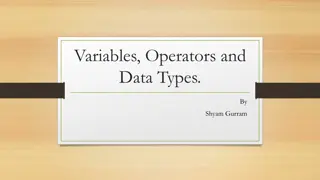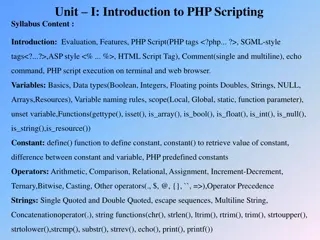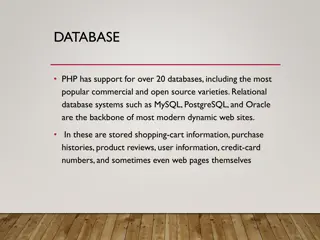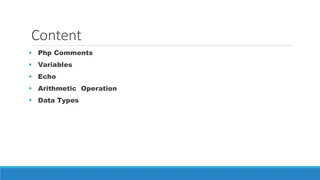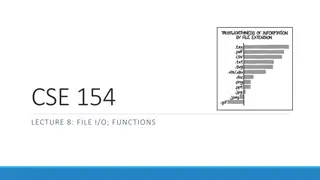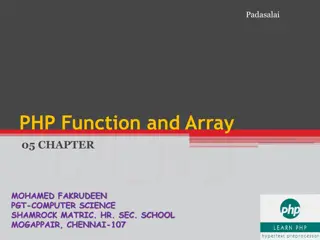
Understanding PHP Data Types
Learn about the different data types in PHP including scalar types like boolean, integer, float, and string. Explore examples and usage of each type to enhance your PHP programming skills.
Download Presentation

Please find below an Image/Link to download the presentation.
The content on the website is provided AS IS for your information and personal use only. It may not be sold, licensed, or shared on other websites without obtaining consent from the author. If you encounter any issues during the download, it is possible that the publisher has removed the file from their server.
You are allowed to download the files provided on this website for personal or commercial use, subject to the condition that they are used lawfully. All files are the property of their respective owners.
The content on the website is provided AS IS for your information and personal use only. It may not be sold, licensed, or shared on other websites without obtaining consent from the author.
E N D
Presentation Transcript
Data Types of PHP programming Presented by Mrs. RautAarti P. Assistant Professor Department of Comp. Sci. & IT. Deogiri College, Aurangabad
PHP:Data Types Data Types defines the type of data a variable can store. PHP data types are used to hold different types of data or values. PHP supports 8 primitive data types that can be categorized further in 3 types: 1)Scalar Types (predefined) 2)Compound Types (user-defined) 3)Special Types
PHP Data Types: Scalar Types It holds only single value. There are 4 scalar data types in PHP. boolean integer Float string
1)PHP Boolean Booleans are the simplest data type works like switch. It holds only two values: TRUE (1) or FALSE (0). It is often used with conditional statements. If the condition is correct, it returns TRUE otherwise FALSE. Example: <?php if (TRUE) echo "This condition is TRUE."; if (FALSE) echo "This condition is FALSE."; ?>
2)PHP Integer Integer means numeric data with a negative or positive sign. It holds only whole numbers, i.e., numbers without fractional part or decimal points. Rules for integer: An integer can be either positive or negative. An integer must not contain decimal point. Integer can be decimal (base 10), octal (base 8), or hexadecimal (base 16).
Example <?php $dec1 = 34; $oct1 = 0243; $hexa1 = 0x45; echo "Decimal number: " .$dec1. "</br>"; echo "Octal number: " .$oct1. "</br>"; echo "HexaDecimal number: " .$hexa1. "</br>"; ?>
3)PHP Float A floating-point number is a number with a decimal point. Unlike integer, it can hold numbers with a fractional or decimal point, including a negative or positive sign. Example: <?php $n1 = 19.34; $n2 = 54.472; $sum = $n1 + $n2; echo "Addition of floating numbers: " .$sum; ?>
PHP String A string is a non-numeric data type. It holds letters or any alphabets, numbers, and even special characters. String values must be enclosed either within single quotes or in double quotes. But both are treated differently. Example: <?php $company = TCS"; //both singleand double quote statementswill treat different echo "Hello $company"; echo "</br>"; echo 'Hello $company'; ?>
PHP:Compound Data Types There are 2 compound data type: 1)Array 2)object
PHP Array An array is a compound data type. It can store multiple values of same data type in a single variable. Example: <?php $name = array ( Pornima", Pallvai", vaishnavi"); var_dump($name); //thevar_dump() function returns the data type and values echo "</br>"; echo "Array Element1: $bikes[0] </br>"; echo "Array Element2: $bikes[1] </br>"; echo "Array Element3: $bikes[2] </br>"; ?>
PHP object An object is a data type which stores data and information on how to process that data. Objects are the instances of user-defined classes that can store both values and functions. They must be explicitly declared. Example: <?php class shape { function square() { $len = 20; echo length: " .$len; } } $obj = new shape(); $obj ->square(); ?>
PHP:Special Type There are 2 types of special data type: 1)Null 2)Resource
PHP Null Null is a special data type that has only one value: NULL. There is a convention of writing it in capital letters as it is case sensitive. The special type of data type NULL defined a variable with no value. Example: <?php $nl = NULL; echo $nl; //it will notgive any output ?>
PHP Resource Resources are not the exact data type in PHP. Basically, these are used to store some function calls or references to external PHP resources. For example - a database call. It is an external resource.





